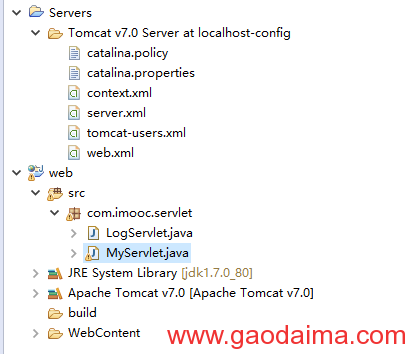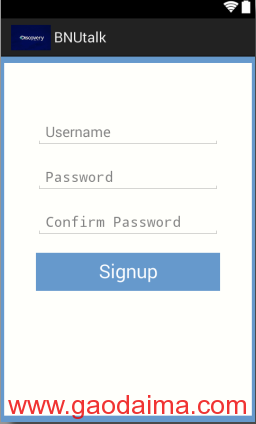Android——Tomcat+mysql+Servlet,实现将Client传入的数据写入MySQL
Android客户端将用户的注册信息上传到Tomcat Web服务器,Servlet将注册信息写入到MySQL中。
1,准备工作
(1)在MySQL中创建好要使用的数据库和数据表。
(2)设置好Tomcat的数据库连接池。
参见Tomcat数据库连接池配置
2,Android客户端Activity和Layout的设计
(1)一个简单的注册界面,sign_layout.xml
sign_layout.xml
<LinearLayout xmlns:android="http://schemas.android.com/apk/res/android" xmlns:tools="http://schemas.android.com/tools" android:layout_width="match_parent" android:layout_height="match_parent" android:focusableInTouchMode="true" android:background="#ff6699cc" android:orientation="vertical" android:paddingBottom="@dimen/activity_vertical_margin" android:paddingLeft="@dimen/activity_horizontal_margin" android:paddingRight="@dimen/activity_horizontal_margin" android:paddingTop="@dimen/activity_vertical_margin" tools:context=".MainActivity" > <RelativeLayout android:layout_width="fill_parent" android:layout_height="fill_parent" android:background="#fffffffb" android:orientation="horizontal" android:padding="40dp" > <EditText android:id="@+id/etSgAccount" android:layout_width="match_parent" android:layout_height="wrap_content" android:layout_marginTop="30dp" android:layout_marginBottom="20dp" android:hint="@string/Account" android:inputType="textEmailAddress" /> <EditText android:id="@+id/etSgPassword" android:layout_width="match_parent" android:layout_height="wrap_content" android:layout_below="@+id/etSgAccount" android:layout_marginBottom="20dp" android:hint="@string/Password" android:inputType="textPassword" /> <EditText android:id="@+id/etSgRePassword" android:layout_width="match_parent" android:layout_height="wrap_content" android:layout_below="@+id/etSgPassword" android:layout_marginBottom="20dp" android:hint="@string/repassword" android:inputType="textPassword" /> <Button android:id="@+id/btnSign" android:layout_width="match_parent" android:layout_height="wrap_content" android:layout_below="@+id/etSgRePassword" android:background="#ff6699cc" android:onClick="onLogin" android:text="@string/signup" android:textColor="#ffffffff" android:textSize="24sp" /> </RelativeLayout> </LinearLayout>(2)编写对应的Activity——SignActivity.java
package com.bnutalk.activitytest; import android.app.Activity; import android.content.Intent; import android.os.Bundle; import android.view.View; import android.widget.Button; import android.widget.EditText; public class SignActivity extends Activity { private EditText username; private EditText password; private Button signup; @Override protected void onCreate(Bundle savedInstanceState) { super.onCreate(savedInstanceState); setContentView(R.layout.sign_layout); username=(EditText) findViewById(R.id.etSgAccount); password=(EditText) findViewById(R.id.etSgPassword); signup=(Button) findViewById(R.id.btnSign); } /*发起HTTP请求*/ public void onLogin(View v) { String url="http://172.22.140.237:8080/web/MysServlet"; new HttpThread(url, username.getText().toString(), password.getText().toString()).start(); } } 其中的重要代码是函数onLogin,它表示当按下Signup按钮时,启动Http线程,向服务器发起Http请求。
/*发起HTTP请求*/ public void onLogin(View v) { /*url要访问的Tomcat的Servlet地址,将ip换成Tomacat所在主机的ip*/ String url="http://172.22.140.237:8080/web/MysServlet"; /*调用访问网络的HttpThread*/ new HttpThread(url, username.getText().toString(), password.getText().toString()).start(); } (3)新建一个Tread类——HttpTread
访问网络属于耗时操作,因此用一个单独的线程来实现。
package com.bnutalk.activitytest; import java.io.BufferedReader; import java.io.IOException; import java.io.InputStreamReader; import java.net.HttpURLConnection; import java.net.MalformedURLException; import java.net.URL; import android.R.string; public class HttpThread extends Thread { String url; String username; String password; public HttpThread(String url, String username, String password) { // TODO Auto-generated constructor stub this.url = url; this.username = username; this.password = password; } private void doGet() throws IOException { /*将username和password传给Tomcat服务器*/ url=url+"?username="+username+"&password="+password; try { URL httpUrl = new URL(url); /*获取网络连接*/ HttpURLConnection conn = (HttpURLConnection) httpUrl.openConnection(); /*设置请求方法为GET方法*/ conn.setRequestMethod("GET"); /*设置访问超时时间*/ conn.setReadTimeout(5000); BufferedReader reader=new BufferedReader(new InputStreamReader(conn.getInputStream())); String str; StringBuffer sb=new StringBuffer(); //读取服务器返回的信息 while((str=reader.readLine())!=null) { sb.append(str); } //把服务端返回的数据打印出来 System.out.println("result"+sb.toString()); } catch (MalformedURLException e) { // TODO Auto-generated catch block e.printStackTrace(); } } /*在run中调用doGet*/ @Override public void run() { try { doGet(); } catch (IOException e) { // TODO Auto-generated catch block e.printStackTrace(); } } } (4)在AndroidManifest.xml中添加网络访问权限
<uses-permission android:name="android.permission.INTERNET"/>如图:
3,Server和Servlet设置
(1)建立好一个server和一个web项目,在web下建立所需的Servlet

如图所示,注册用到的Servlet是MyServlet.java,请忽略LogServlet.java
(2)在web.xml中注册Servlet
<servlet> <servlet-name>DataServiceServlet</servlet-name> <servlet-class>com.imooc.servlet.MyServlet</servlet-class> </servlet> <servlet-mapping> <servlet-name>DataServiceServlet</servlet-name> <url-pattern>/DataServiceServlet</url-pattern> </servlet-mapping>如图所示:
(3)编写MyServlet.java
package com.imooc.servlet; import java.io.IOException; import java.io.PrintWriter; import java.sql.*; import javax.naming.InitialContext; import javax.naming.NamingException; import javax.servlet.ServletException; import javax.servlet.annotation.WebServlet; import javax.servlet.http.HttpServlet; import javax.servlet.http.HttpServletRequest; import javax.servlet.http.HttpServletResponse; import javax.sql.DataSource; import org.apache.catalina.Context; import com.mysql.jdbc.Connection; import com.mysql.jdbc.ResultSet; import com.mysql.jdbc.Statement; /** * Servlet implementation class MyServlet */ @WebServlet("/MyServlet") public class MyServlet extends HttpServlet { private static final long serialVersionUID = 1L; /** * @see HttpServlet#HttpServlet() */ public MyServlet() { super(); // TODO Auto-generated constructor stub } /** * @see HttpServlet#doGet(HttpServletRequest request, HttpServletResponse * response) */ protected void doGet(HttpServletRequest request, HttpServletResponse response) throws ServletException, IOException { this.doPost(request, response); } /** * @see HttpServlet#doPost(HttpServletRequest request, HttpServletResponse * response) */ protected void doPost(HttpServletRequest request, HttpServletResponse response) throws ServletException, IOException { /*获取请求的数据,并向控制台输出*/ String username = request.getParameter("username"); String password = request.getParameter("password"); PrintWriter out = response.getWriter(); System.out.println("username" + "," + username); System.out.println("password" + "," + password); int rs ; String sql = "insert into bnutalk(id,username,psswd) values(3,?,?)"; /*实现向MySQL中插入username和password*/ try { InitialContext ctx = new InitialContext(); DataSource ds = (DataSource) ctx.lookup("java:comp/env/jdbc/t1"); /*获得数据库的连接*/ java.sql.Connection conn =ds.getConnection(); conn = ds.getConnection(); /*执行sql*/ PreparedStatement ps = conn.prepareStatement(sql); ps.setString(1, username); ps.setString(2, password); rs= ps.executeUpdate(); } catch (SQLException se) { System.out.println("SQLException: " + se.getMessage()); } catch (NamingException ne) { System.out.println("NamingException: " + ne.getMessage()); } } } 4,运行
(1)运行web项目,run on server
(2)运行Android客户端
如图:
先看看此时数据表中的内容:
(3)注册一个用户
用户名和密码都是csdn
控制台输出:
再次查看数据表:
如果有看不懂的,可以先去补一补Servlet,Tomcat数据库连接池,MySQL,Thread这些基础知识,有个大概印象,最起码能知道其中的逻辑,大体框架,实现机制。脑海中一个框架图,再来看代码就很简单了。
欢迎大家阅读《Android——Tomcat+MySQL+Servlet,实现将Client传到的数据写入MySQL_mysql》,跪求各位点评,by 搞代码












